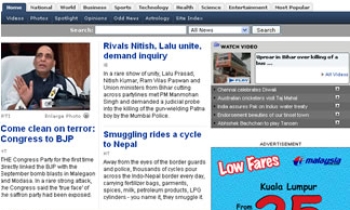Britain's Guardian newspaper, a venerable 184-year-old broadsheet, has become the latest major daily to convert to a compact format in a bid to win back younger, time-pressed readers who often turn to electronic means to get their news.
Unlike its rivals -- The Times of London and The Independent, which have converted to the smaller tabloid format -- The Guardian has chosen the "Berliner" format, a size midway between broadsheet and tabloid that is favoured by several major continental European papers.
The new size combines "the convenience of a tabloid with the sensibility of a broadsheet," Guardian editor Alan Rusbridger said.
The experimentation with formats comes at a time when newspapers around the world are scrambling to find a solution to a serious long-term problem: the erosion of circulation and readership in the face of intense competition.
"Quality" papers are being hit by the advent of free commuter papers, along with a burgeoning array of news websites, blogs and other electronics means of disseminating information.
Ironically, one of the Guardian's problems was the success of its own website, one of the most popular among British newspapers. Guardian executives have admitted that some readers deserted the printed edition to get their news from the paper's Internet site.
The shift to a smaller size has a number of advantages. It is easier for commuters to handle, newsprint prices are lower, and new presses used for the format often allow for more colour. Research also shows younger readers prefer the smaller formats.
But there are drawbacks. There is less room for spectacular layouts, and it can be difficult to persuade advertisers to pay the same price for full-page advertisements.
Still, some newspaper industry observers say the Guardian's shift could sway more publishers to consider a change, even in North America where downsizing has been far less frequent than in Europe.
"This is going to be the catalyst that is really going to get people in North America to pay attention," said Len Kubas, a consultant who runs Toronto-based Kubas Consultants. The Guardian's compromise Berliner format could prove attractive for those hesitant to downsize, he added.
Mr. Kubas is convinced that issues surrounding the pricing of advertising in the smaller formats can be overcome, especially now that advertisers are becoming more open to what he calls "impact pricing" -- setting ad rates based on the impact of an advertisement rather than purely on its size.
Others aren't convinced the trend will accelerate in North America, where only a handful of papers have shifted format. "Canadian newspapers are certainly watching the debate very closely, but I think the jury is still out," said Anne Kothawala, president of the Canadian Newspaper Association.









